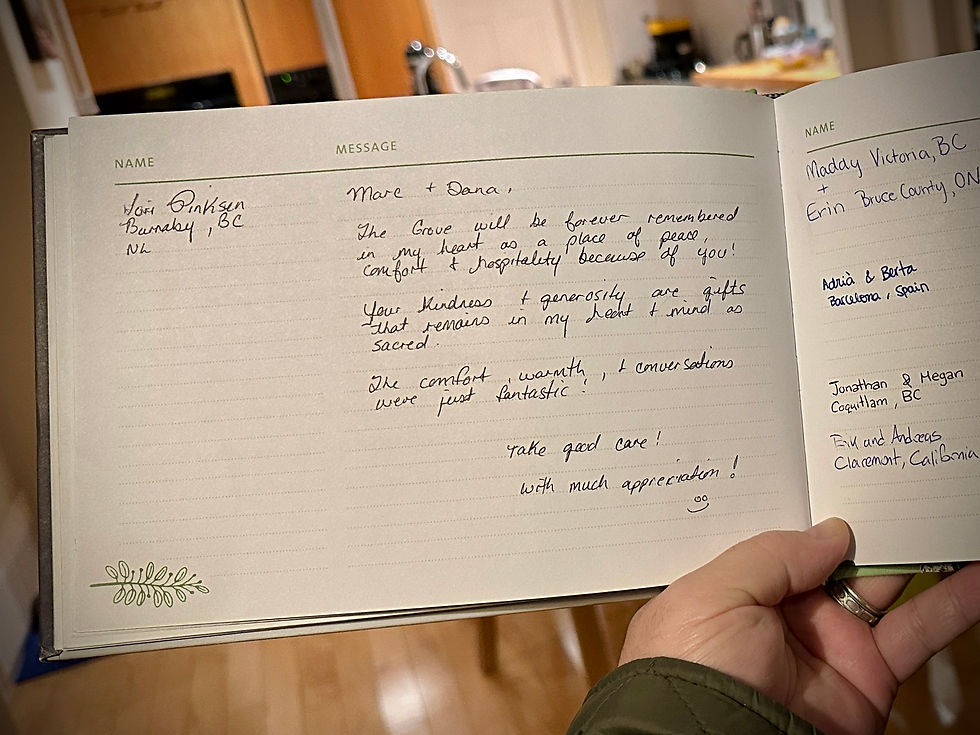Can you dig it?
- Marc S. Tremblay

- Jun 11, 2023
- 3 min read
Updated: May 8, 2024
With the trees and logs out of the way, Matt T started excavating where the house will sit.
Normally, excavation starts once the building permit is issued, but the quick house delivery timeline meant we needed to dig first, bring the house over, then apply for the building permit. We didn't have a choice, really, storing the house for months would have cost tens of thousands more, and asking for forgiveness is often easier than permission, right?

Excavation started easy. The topsoil was bone dry, dusty, silty and sandy, with some rocks and clay, as Matt dug past two feet down.
Past the two-foot mark, Matt hit sandstone veins and large boulders, but his big machine, "Bam-Bam" as he calls it, made short work of scrapping, cracking and removing rocks. Considering Mayne is an island in the Salish Sea, it's not surprising that bedrock was sitting not far below ground level. Our neighbours' rocky properties also provided clues of what was below the surface.

As the hole got larger and deeper, the mounds of dirt around it grew larger with every bucket-full. Every once in a while, a roundish boulder would roll off the dirt pile and roll down the sloping lot. This massive one made it about 80 feet down towards the ocean. Turns out the French saying is right: "pierre qui roule n'amasse pas mousse."
The rock started to get harder to break up. The hardest was blueish sandstone. We knew hitting big rock was a possibility, so we had considered our options in advance: 1. we stop digging and the house sits much higher than planned on the lot (not ideal to allow for a walk-out lower level); 2. Matt attaches his "breaker" to Bam-Bam and breaks-up the rock; or 3. we use dynamite.
Although it would have been kinda fun blasting it, dynamite wasn't an option since it would have taken weeks to organize a blasting crew to come to Mayne Island. Blasting is also pretty pricy.
Letting the house sit higher on the lot also wasn't a great option since we didn't want to have to build up the ground around the house, and have to to step up several feet to get into it. This left us with one option, a relatively happy medium, that of Matt using Bam-Bam's breaker to crack some the rock, then slinging it out of the hole to get a few feet deeper. The excavated hole ended up being about 8 feet deep, while we were hoping to get to about 10-11. Not too bad.
While this was happening, Nickel Brothers' Operation Manager, Casjen, came to check on our progress.
I was concerned that we wouldn't be able to finish the excavation and driveway prep on time for the house to be delivered on June 13, but he reassured us that we were in good shape.

He directed Matt on how to widen the driveway to allow their truck and dollies to back the 60-feet-long house onto our lot. Matt used tons of rocks and dirt he'd been digging up over the last few days to build-up, strengthen and widen the driveway to Casjen's specifications.
Tomorrow, June 12, one day before the house arrives, I'll help Matt ensure the excavated hole is levelled. That's right, I learned a new skill, that of using a fancy Bosch laser-level to help Matt know where he needs to dig more, or add fill.

The final step will be for Wey Mayenburg Land Surveying Ltd. to come re-survey the lot. They surveyed it a couple of years ago, right after we purchased the property, but we need to do it again.
They'll mark the set-back line to make sure we respect the distance required to the back lot line, 3 meters, and they will set-up stakes to identify where the house corners should be, in the excavated hole. Once that's done, it's Nickel Brothers' job to line up the house as close to the house corners as possible, then support it with big wooden blocks, 11 feet in the air.
Even though Matt moved tons of dirt and rocks this week, we're not done digging. Once the house is in position and the sewerage engineer finalizes the design for the septic system, he'll be back to work on that, but that's several weeks away.
For those who are more curious about digging and rock-breaking, check out this video of some of the work done this past week at the Grove.
Next up, house delivery!














Comments